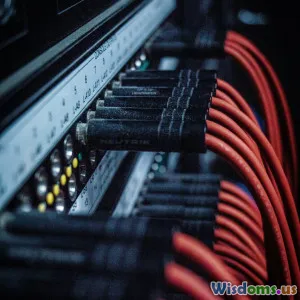
Latency Reduction Techniques You Are Probably Overlooking
8 min read Uncover overlooked latency reduction techniques that can dramatically improve your system’s responsiveness beyond typical solutions. (0 Reviews)
Latency Reduction Techniques You Are Probably Overlooking
Latency—the delay before a transfer of data begins following an instruction—can make or break the performance and user experience of digital systems. Whether streaming a video, playing an online game, or executing trades in financial markets, milliseconds count. Though conventional strategies like upgrading bandwidth, CDN utilization, or server enhancements are well-known, many engineers and developers overlook subtle yet transformative latency reduction methods.
This article uncovers several underutilized approaches to cutting latency. We’ll explore the core concepts, provide concrete examples, and illuminate real-world use cases. By the end, you’ll be equipped to challenge assumptions about latency fixes and uncover optimization avenues you may never have considered.
Understanding Latency Beyond Bandwidth
Latency is distinct from bandwidth; it’s the time delay, not throughput capacity. While it's tempting to think increasing bandwidth resolves all delays, latency often stems from deeper architectural, software, or routing inefficiencies. For instance, trading applications require ultra-low latency—fractions of milliseconds matter—yet simply adding bandwidth isn’t enough.
This calls for tailored techniques focused on:
- Data processing speed
- Data path optimization
- Resource prioritization
- Intelligent software design
Overlooked Latency Reduction Techniques
1. Intelligent Caching Policies Beyond Traditional Expiry
Caching is one of the oldest and most effective latency reducers. However, most systems rely on simple time-to-live (TTL) mechanisms that evict data after fixed intervals. This approach can be inefficient.
Advanced Concept: Employ adaptive caching policies that prioritize cache freshness based on data usage patterns and network conditions.
Example: Google’s web cache algorithms dynamically adjust content expiration based on user access and change frequency, ensuring users access the freshest, fastest content with minimal delays.
Real-World Insight: Netflix employs predictive caching, preloading content for users based on viewing habits and upcoming releases, reducing play-start delays even in bandwidth-constrained environments.
2. Optimizing TLS Handshakes with Session Resumption and Zero-RTT
Security protocols frequently add overhead. The TLS handshake, necessary for HTTPS, adds latency by establishing encryption parameters.
What’s Overlooked? Many developers neglect session resumption and modern extensions like TLS 1.3’s zero round-trip time (0-RTT) feature.
- Session Resumption: Allows clients to reuse previously negotiated session keys, shaving handshake time from hundreds of milliseconds to near zero.
- 0-RTT: Permits clients to send data immediately without waiting for handshake completion.
Example: Cloudflare reported a reduction of 50%-70% in TLS handshake latency upon adopting TLS 1.3 0-RTT at their edge servers.
3. Employing Edge Computing for Proximity-Based Processing
Latency is heavily affected by physical distance. Data round trips to distant data centers add unavoidable delay.
Innovative Practice: Distribute processing vertically closer to users via edge computing platforms.
Example: AWS Lambda@Edge allows running code within CloudFront edge locations—mobile apps relying on backend functions experience faster response times because logic runs geographically nearer to the user.
Data Point: According to Akamai, utilizing edge compute can reduce median latency from 100ms to under 20ms for global user bases.
4. Prioritizing Resources and Requests in Queues
Queues and buffers are double-edged swords. While smoothing bursts, busy systems often treat requests equally, causing high-priority or latency-sensitive operations to endure unnecessary delays.
Solution: Implement differentiated quality of service (QoS) with priority queues.
Example: Google's QUIC protocol integrates packet prioritization, enabling video streaming segments to be transmitted with higher priority over low-latency chat messages inhabiting the same TCP connection.
Industry Insight: Research from IEEE signals through proper scheduling, latency jitter can be drastically minimized, enhancing real-time communication.
5. Reassessing Code Execution Flow for Critical Paths
Developers often overlook the significance of identifying and accelerating critical execution paths—the parts causing most delay.
Technique: Conduct critical path analysis (CPA) in software to pinpoint latency bottlenecks.
Case: Facebook engineers uncovered that optimizing React.js rendering critical paths cumulatively saved millions of CPU cycles daily, enhancing page load times by an average of 15%.
Tools like Chrome DevTools Performance tab or Intel VTune can help visualize and isolate these paths.
6. Using Protocol Buffers and Efficient Data Serialization
Serialization format plays a crucial role in transmission speed; bulky or verbose formats add overhead.
Innovative Approach: Switch from text-heavy JSON/XML to compact binary serialization protocols like Protocol Buffers or FlatBuffers.
Example: Google's services widely use Protocol Buffers, citing serialization speed up to 20x faster than JSON.
Less data size results in fewer bytes over networks and quicker parsing, directly reducing perceived latency.
7. Leveraging Predictive Prefetching and Machine Learning
Anticipating user needs rather than reacting can drastically trim delay.
Forward-Thinking: Apply machine learning to predict next user actions and prefetch necessary resources.
Example: Google Search prefetches top predicted search results links, loading them in the background. This initiative leads to near-instant loading times when users click links.
Data Insight: A 2017 study from Stanford showed predictive loading reduces median web latency by approximately 30%.
Beyond the Code: Organizational and Architectural Considerations
Reducing latency isn't merely a technical challenge—it's about culture and architecture.
- Cross-Team Collaboration: Alignment between front-end, back-end, and network teams accelerates identification of latency sources.
- Chaos Engineering: Proactively testing failure modes can reveal latency spikes for early mitigation.
- Observability & Monitoring: Real-time tools like distributed tracing assist in pinpointing milliseconds wasted across service boundaries.
Conclusion: Rethink Latency Reduction Holistically
Traditional approaches to latency reduction—like expanding bandwidth or adding caching—are essential but not exhaustive. Overlooked techniques such as adaptive caching policies, TLS optimizations, edge computing, priority-based request management, critical path acceleration, efficient serialization, and predictive prefetching often deliver outsized performance improvements.
These strategies demand nuanced understanding and investment but pay dividends by producing speedier, more responsive systems that delight users and outperform competitors.
As Jeff Dean, Google’s renowned engineer, advocates: "Optimization today can enable mountains of innovation tomorrow." Don’t settle for latency shortcuts everyone knows; dive deeper, embrace these overlooked approaches and experience the unbeaten paths to ultra-low latency.
References:
- "The QUIC Transport Protocol: Design and Internet-Scale Deployment," J. Iyengar et al., ACM SIGCOMM 2017
- "TLS 1.3: Traffic Encryption and Latency Improvements," Cloudflare Blog, 2019
- "Understanding Critical Path Analysis for React Applications," Facebook Engineering, 2020
- "Predictive Prefetching Techniques Reduce Web Latency," Stanford Report, 2017
- Akamai State of the Internet Report, 2021
Rate the Post
User Reviews
Popular Posts



















